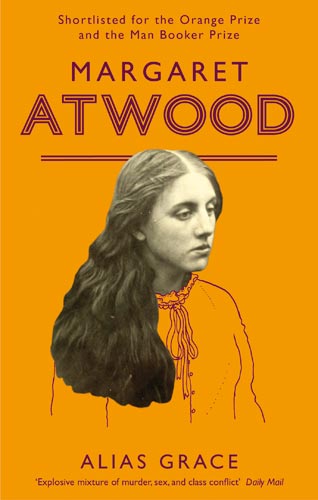 Alias Grace is one of those novels that feels like taking
deep breaths of fresh air. It just fills you with something that feels
substantial and essential. All in, it's a rich and vibrant historical novel that asks questions about women's lots throughout history, the nature of justice and its connection with the press, the history of mental illness and the cult of the paranormal.
Alias Grace is one of those novels that feels like taking
deep breaths of fresh air. It just fills you with something that feels
substantial and essential. All in, it's a rich and vibrant historical novel that asks questions about women's lots throughout history, the nature of justice and its connection with the press, the history of mental illness and the cult of the paranormal.
The book follows the life of Grace Marks “celebrated”
murderess, one time mental institution inhabitant and one of the most infamous
Women of Canada’s 19th Century. Convicted at the age of 16 (along with the
surly stable hand) of murdering her wealthy employer and his housemaid
mistress, she is spared the gallows at the last moment and sentenced to life in
prison. She claims to have no memory of the day that her employer died, but
gave several differing accounts of her whereabouts and actions during her court
appearances, which certainly didn't do
much for her defence case.
Doctor Jordan, a well-bred but financially unstable
specialist in mental health (or as expert as it is possible to be, considering
the time) takes an interest in Grace’s case. He aims to coax the details of the
murder from her, convinced that she has buried them deep within her memory and
sets about arranging weekly meetings with her in the home of the prison warden.
The two strike up an unlikely friendship based initially on
vegetables. The doctor writes many letters to his colleagues, friends and
mother detailing the contemporary medical theories on women, hysteria and
afflictions of the mind. His narrative attention frequently finds itself
returning to thoughts of Grace, considering her story and remembering her posture,
complexion or some element of the press’ reportage of her case.
Grace’s narrative is complicated, occasionally contradictory and thoroughly tragic. The reader is never really
sure whether she is disclosing the truth to Dr. Jordan or only telling him what
he wishes to hear, maybe simply telling an elaborate story to amuse herself. She could be a skilled manipulator and liar; the whole thing could be an impressive performance. We're never even sure, as the reader, which parts Grace is saying. The line between thought and speech seems purposefully vague and the relationship between action and idea recurs regularly- Grace herself points out at one point that "If we were all on trial for our thoughts, we would all be hanged".
I'm thoroughly convinced that Margaret Atwood will turn out to be like, the Dickens of the post-Dickens era. Her ability to get inside the heads of her characters is uncanny. Even the most fleeting characters instantly jump off the page. The book is based on a true story; Grace Marks was a real person that spent X many years in prison for the murder of Nancy Montgomery and Thomas Kinnear. Contemporary newspaper articles and likenesses add context and authority to the story- I loved Atwood's decision to keep referring the reader to the contemporary press articles relating to the Marks case. We assume that media influence and one-sided news reporting is a new phenomena, but Atwood points out that as early as 1840s, papers were printing (potentially) slanderous and thoroughly contradictory stories, pointing fingers and passing judgement. , and it’s practically impossible to tell where the fact ends and the fiction begins. Each seems so dependent on the other, but neither dominates. It’s hard to describe fictionalised fact when it’s done so well and so seamlessly.
I'm thoroughly convinced that Margaret Atwood will turn out to be like, the Dickens of the post-Dickens era. Her ability to get inside the heads of her characters is uncanny. Even the most fleeting characters instantly jump off the page. The book is based on a true story; Grace Marks was a real person that spent X many years in prison for the murder of Nancy Montgomery and Thomas Kinnear. Contemporary newspaper articles and likenesses add context and authority to the story- I loved Atwood's decision to keep referring the reader to the contemporary press articles relating to the Marks case. We assume that media influence and one-sided news reporting is a new phenomena, but Atwood points out that as early as 1840s, papers were printing (potentially) slanderous and thoroughly contradictory stories, pointing fingers and passing judgement. , and it’s practically impossible to tell where the fact ends and the fiction begins. Each seems so dependent on the other, but neither dominates. It’s hard to describe fictionalised fact when it’s done so well and so seamlessly.

No comments:
Post a Comment